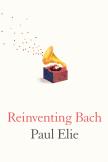Harmonic Convergence
Reinventing Bach is a curious and wonderful book, delightful and challenging at the same time. Among musicologists and classical music lovers, Johann Sebastian Bach’s place in the canon of western music is secure, but what Paul Elie demonstrates is that Bach has a place much bigger than that. His music continues to engage on so many levels. Bach now can be experienced on a global level, interacting with musics of many cultures, which are constantly being drawn into partnership with the legacy of the one whom many of us consider the greatest composer of the Baroque age, if not the whole of the Western tradition itself.
Elie tells us how and why this happened in a prose that is cognate with the musical forms and procedures that Bach used in his own creative and very personal vein. At the end of Reinventing Bach Elie says, “…our experience of the [Bach] recordings, as the recorded life of Bach reveals, has made us fluent in the practices that traditions of the spirit prize: scrutiny of the past, communication across the ages, a reluctance to judge by appearances, and the recognition that the dead continue to speak and the sounds they make, amplified right, are a kind of music.”
This is the meaning of this curiously inventive book, a book that performs a literary counterpoint among the various stories that the author tells to enlighten our hearts and minds with the depth and spirituality of the music of Bach—but not only that. The author imitates in his craft that spirit of invention that he carefully shows characterized the music of the great master. It takes some time before the reader understands why in any deep way the personalities he chooses and their stories are allowed to invade this life of Bach, but eventually the literary invention becomes clear. It is a vehicle to engage the invention of Bach himself. The book itself is not about only the music of J. S. Bach and the effect of his music through the centuries since his death. The book is also a narrative of the technology of recording and how various well-known musicians contributed in astounding ways to the historical narrative around that technology that we usually take for granted.
Musicians have been arguing ever since the first wax cylinders appeared in the 19th century about the importance of recorded music and whether this technology is ultimately useful, pedagogically or otherwise, or whether it is simply ruining the experience of live music. For once, someone has pushed this question to the center of our discussion and demonstrated that indeed Bach’s greatness has depended on, and grown spectacularly by recording history’s electronic memory, fully engaged now for more than 100 years, beginning with Albert Schweitzer’s first Bach recordings in the 19th century. This is the “new way,” as Elie calls it, “that will have profound effects on the nature of the art and its place in our society.”
Who are the personalities who create the counterpoint that relates the greatness of Bach with the history of recording technology? Several figures appear as musical ositinatos. They repeat their appearances in the text just as an ostinato repeats in a musical context as a compositional procedure. These are Albert Schweitzer, the organist/theologian and medical doctor missionary who wrote the first important life of Bach and was the first musician to record music of Bach; Pablo Casals, the Catalan cellist who as an artist embraced the cause for peace in the world; Leopold Stokowski, the famous conductor of the Philadelphia Orchestra whose influence on the development of sound technology began in earnest with his collaboration with Walt Disney on “Fantasia”; and Glenn Gould, the eccentric and brilliant pianist who more than any other, perhaps, created the space where new recording procedures managed not only to develop, but to spin a rhetoric that seems akin to a new and separate aesthetics.
This surprisingly has led to a reconciliation of these new listening experiences with the age-old experience of live music. There are other characters who enter the narrative to a lesser degree. These are more like recurring themes in the narrative: Wanda Landowska, Rosalynd Tureck, Yo Yo Ma, Judy Collins, the Beatles, Lorraine Hunt, Steve Jobs and Keith Jarrett, as well as a number of directors of early music ensembles. What is astonishing is that Elie author manages to fairly chronicle the American music scene for most of the 20th century up to the present day and relate it to Bach. Certain Bach pieces also become touchstones: the “Two- and Three- Part Inventions,” the “Toccata and Fugue in D minor,” the cello suites, the “Well-Tempered Clavier” and above all, the “Goldberg Variations,” which are par excellence the example of Bach’s respect for, and absolute mastery of invention as a musical form.
Elie catalogs an amazing number of performances in modern times of the “Goldberg Variations,” not only on piano or harpsichord, but an infinite array of instruments. (I am surprised he missed a performance in Tokyo, September 2007, of the Goldbergs on an accordian by the Finnish concert accordianist Mika Väyrynen!) These works and others are woven into the narrative, but Elie often gives interpretation and commentary that is usually spot on. After finishing the book, I could not wait to hear again “Cantata 82,” Ich habe genug, so moving was the author’s testimony. The kaleidoscopic perspective of this book is thrilling and very satisfying.
This article also appeared in print, under the headline “Harmonic Convergence,” in the February 4, 2013, issue.








